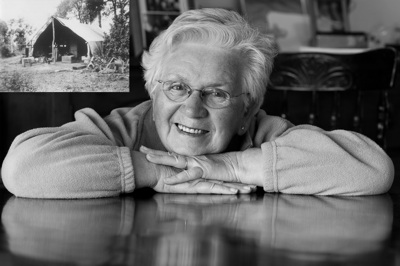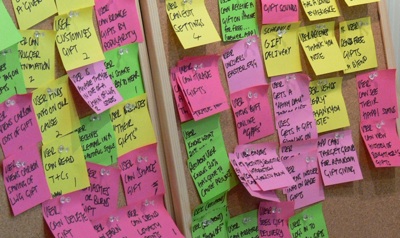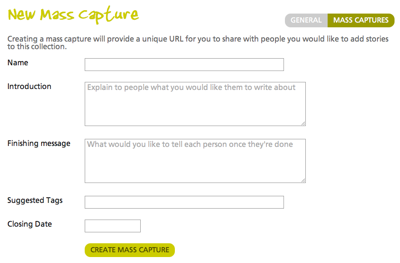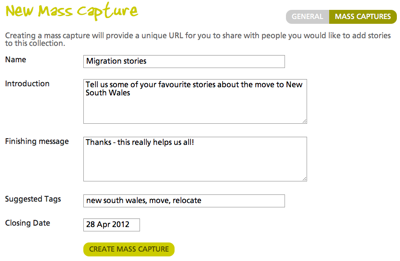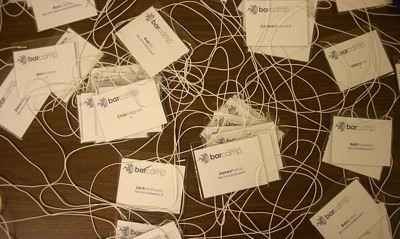Zahmoo for developers: personas
When developing a new system – software, business-process, whatever – it’s still all too common to refer to the people who will interact with that system as ‘the users’. Abstract. Faceless. A machine talking to a machine.
But our users aren’t like that at all. They’re real people, with real stories, like Alice Lewis above. Her smiling face may not show it now, leaning on a treasured table, but she’s known real hardship, an early childhood living rough, catching rabbits to stay alive. How will someone like her use your system? Don’t be fooled by her appearance: she might seem soft on the surface, but she’s as tough as teak underneath. And life is hard enough already, thank you; she doesn’t have the time or energy to tolerate the flaws and foibles and failings of a badly-designed system.
So when you design your system, or derive the requirements for its development, don’t think in terms of an abstract ‘user’: think about someone real, like Alice. Use her real story as the basis for a persona that you can use to test the functions and limits of your system
And to do that, start from the usual story-cues that we’ve seen before on this blog:
- the people – Alice, and the people she interacts with in your system
- the time – time of day, time of year, time and timing in general
- the place – where these events will happen
- the sequence of events – her touchpoints and interactions with your system
- her ‘why’ in each interaction – her aims, her intent, her criteria for satisfaction
To make this work well, we’ll typically split this ‘persona-story’ into three parts, or three layers:
- the persona-story itself: a brief ‘life-picture’ of Alice and each of our other personas – what they look like, who they are, what they can and can’t do, and so on
- the interaction-story: a summary of each overall interaction with our system, each ‘customer-journey’ to resolve a specific overall need – typically structured as an ‘epic’ in the form of “as a <type of user>, I want <some goal> so that <some reason>“
- the small user-stories: the point-by-point detail-layer interactions at each touchpoint with the system – what exactly this persona must or must not do in order to achieve their aim
Record each of these story-items in Zahmoo, with links between each of the story-items, and to the respective requirements and tests. As you go through the system-development processes, use comments in Zahmoo to keep track of ideas and implementations, and changes to the stories themselves.
So what’s the story here? How well can your system serve the needs of someone like Alice, with arthritic fingers, fading eyesight, fragile memory and a decidedly testy temperament? Because if it doesn’t work well, from her perspective, she’ll let you know exactly what she feels about it, in “language that could blister wallpaper”!
—-
Image credit: Alice Lewis by Rain Moth Gallery under a Creative Commons BY-2.0 licence.
Filed in: For Business, For Community, How to
Permalink | Comments Off on Zahmoo for developers: personas
Zahmoo for developers: whose story?
If we’re developing a system or process based on user-stories, from whom do we capture those stories? Whose story is it?
The temptation, of course, is to write all of those stories ourselves – but in general that’s not a good idea. (The one time when it is useful to do that is when we’re ‘scratching an itch’, as programmers call it – building something to solve a practical problem of our own. But in that case, we may well end up being the only user – which also might not be a good idea.)
We also need to be careful about whose perspective we use. The temptation here is to build from our own viewpoint – after all, it’s our system, our process. But that too is rarely a good idea: remember Chris Potts‘ dictum from recrEAtion, that “Customers do not appear in our processes – we appear in their experiences”. We’re always part of a larger picture, and it’s in the links between the different parts that essential items so easily get lost. What our users will need here is a seamless flow across the whole of their story – so the user-stories we need here will show the connection to that larger picture, rather than solely our own part in that picture.
For example, take the literal metaphor of the market. Our system acts like a tiny window onto the overall market, and our users connect to our system through that tiny window onto the – to us – ‘outside world’. What we need to know is what would make it easy for them to talk with us – and what might get in the way.
Are we blocking the window with our advertising, our wares?
Is the window so small that it blocks out the possibility of conversations with other would-be users?
Is there so much clutter and chaos around the outside of the window that they can’t even get to see us?
What else is going on out there in the marketplace that might distract them, or disconnect them from our story?
And who are our users anyway? How would they identify themselves as our users? How and why do they choose – or not-choose – to be part of our story? What helps them make that choice? – and, equally important to us, the appropriate choice?
So that’s an important question here: whose story?
It’s not just our own story – the whole point is that it’s always a wider story, a shared story, that extends beyond just our own part of that overall story-space. Use Zahmoo to capture those broader user-stories, and connect them to the smaller stories that we need for our system- or process-design.
—
Image credit: Buying cheese by Space][rucker (‘fretro’) under a Creative Commons BY-ND-2.0 licence.
Filed in: For Business, For Community
Permalink | Comments Off on Zahmoo for developers: whose story?
Zahmoo for developers: keep track of the big-picture
“In his role as family caterer, Mr Carrington buys potatoes at the Tuesday Market, completing his shopping-list for the day.”
The phrasing conforms to the structure for an Agile ‘user-story’; it even conforms to the structure we recommend for general story-capture, with people, place, time, context and event. But we’d have to admit that it’s not much of a story!
One of the risks for developers – whether developing process, software or community – is getting lost in all the detail, with all the myriad of tiny user-stories like this one.
So to make sense of what’s going on – and to avoid delivering something that’s technically correct but of little real value – we need to be able to keep track of the big-picture. And link all of the small-stories back to that big-picture.
One of the most useful guidelines we’ve found for this is a quote from enterprise-architect Chris Potts, in his book recrEAtion:
“Customers do not appear in our processes – we appear in their experiences”
Or, from a story-perspective, “we appear in their stories“.
In Zahmoo, collect stories that start from this ‘outside-in’ view:
- Who are our equivalents of Mr Carrington?
- What are their bigger-picture roles, equivalent to Mr Carrington’s role of ‘family caterer’?
- What are their needs, their drivers, their experiences, their stories?
- At what time, in what place, with what events, and with what results, does each part of their experience take place?
Perhaps even more important, because it describes how we can add value (or fail to add value):
- Where do those roles and experiences touch our processes?
- What works for them, in their experience of our process, or someone’s process?
- What doesn’t work for them? In what ways are they forced to ‘fill in the gaps’ in someone’s process?
The more we can make their story seamless, and the more we can reduce the frictions and irritations in their experience, the more perceived-value we’ll create for them. Yet we’ll only be able to see that value if we can maintain the link to their big-picture story.
Over time we’d work our way down from the big-picture ‘epics’ to the necessary fine-detail of the Agile-style user-stories. And we’d record all of these types and layers of story within Zahmoo.
But as we do so, we’d also remember to use the metadata and the link–mechanisms to maintain those links between stories. That’s the way we make sure that we don’t lose track of the big-picture – and ensure that we do deliver real value through our development-project.
—
Image credit: Buying potatoes by Anthony Albright under a Creative Commons BY-SA-2.0 licence.
Filed in: For Business, For Community
Permalink | Comments Off on Zahmoo for developers: keep track of the big-picture
Easter in Antigua
Semana Santa – Holy Week – in Antigua, the former capital city of Guatemala. And this isn’t Disneyland, a made-up procession for tourists: this is a deeply-religious festival that goes back four centuries and more, and that brings together all of the different peoples of this place. That float of the virgin is a heavy burden, difficult to balance, difficult to control – and those women have all volunteered to carry it on their shoulders, throughout its long winding path through the cobbled city streets, as a personal expression of their faith.
A true story: a story of people, place, time, events and meaning.
Yet if you’re in that procession, how do you hold to the truth of that story, when all around you are tourists and others, jumping and jostling, thrusting their cameras in your face? How do you hold the meaning, when others around you see only the spectacle, but not the story?
And if you’re a tourist there, what do you need to help you see beyond the spectacle to the deeper story? How can you connect with the stories behind the story – and the stories beyond those stories too?
Whilst you travel, use Zahmoo to help you capture and share all those stories, in text, in video and in sound. There’s a lot of meaning there…
Zahmoo for developers
Here at Zahmoo, a theme we’ve been working on a lot over the past few weeks has been around story for software-developers.
Most styles of Agile-development methods such as Scrum, XP and Open Unified Process base their code not on predefined requirements but on evolving ‘user-stories’ – ideally gathered directly from the end-users themselves. Yet what we’ve discovered is that the Agile view of ‘story’ is rather different from the perspective we’ve used in Zahmoo – and we think there’ll be a lot of value in bringing them closer together.
In Agile, a typical ‘user-story’ is a very brief one-line statement, of the form:
- “as a <type of user>, I want <some goal> so that <some reason>“
Sometimes this will be simplified to a form such as “user can <do something> (because <some reason>)” or “something <is done> for user (because <some reason>)”, as can be seen in this prioritised, sorted set of user-stories for a software-project:
So in this kind of software-development, a ‘user-story’ is a small actionable item around which an identifiable and discrete block of code can be written. Anything much larger than this is probably too big to use: it’s often is described as an ‘epic’, and will need to be split into smaller chunks before it can be used.
But in breaking things up in this way – especially down to such a small scale – there’s a real risk of literally losing the plot, losing connection with the larger story. In Zahmoo, as you’ve seen from other posts here, we tend to regard a story as made up of the following components:
- a time;
- a place;
- one or more people;
- a sequence of events; and, usually,
- a ‘why’ or lesson-learned
Or there’s what Anecdote describes as the ‘story spine’:
- Way back when…
- everyday…
- But one day…
- Because of that… and because of that… and because of that…
- until finally…
- so ever since then…
- And [optional] the moral of the story is…
That kind of story keeps us connected to the bigger-picture – and keeps us connected with people, too. But it isn’t actionable in the sense that the software ‘user-story’ would be: to a developer, it’s a ‘epic’ that would need to be split further.
In practice, we need both types of stories: the user’s story, and the much smaller fragments of ‘user-story’. Yet we can store both types of story in Zahmoo, and link them together, via tags, comments and links. That way we gain the best value out of all forms of narrative-work for Agile and the like: the best of both worlds.
So there’s a lot of value there in Zahmoo for software-developers. We’ll explore this theme in more depth over the next few posts.
—-
Image credits: Prioritizing user-stories with our Docs by HGruber under a Creative Commons BY-SA-2.0 licence; Stickies by Katie Lips under a Creative Commons BY-2.0 licence.
Filed in: For Business, For Community
Permalink | Comments Off on Zahmoo for developers
Get everyone involved in the story
You know how to use Zahmoo to record stories for your business, your community, your family. But how do you do that when you can’t meet with those people yourself? – and even more so when those people are scattered across the state, or even on the far side of the globe?
Zahmoo has a way to help you do this too, using what it calls ‘Mass Capture’. More precisely, it’s a way for those other people to capture their own text-stories in Zahmoo for you, via an internet-address that you publish to them.
To set up a mass-capture:
- from anywhere in Zahmoo, click on Settings (in the main command-bar)
- click on the Mass Captures button (below ‘Settings’)
You’ll now see this screen:
Fill in the details:
- Name – the project-title that people will see
- Introduction – some text to describe what kind of stories you want them to tell you
- Finishing message – what they’ll see as a thank-you message when they’ve posted the story
- Suggested tags – some example tags that they could use with the story
- Closing date – the last date at which the published internat-address can be used
And you should end up with a screen something like this:
When you’re done, click on the Create Mass Capture button, and you’ll see a screen like this:
Copy the internet-address (URL) from the text-field (the small button to the right of the field will do this for you) and paste it into an email or Twitter-message or whatever to send to your storytellers.
When they paste that URL into their web-browser, they’ll see a screen like this:
They should then fill in the form as shown, with their contact-details at the top (the ‘Organisation’ field is optional, though often useful for communities and businesses), and then the story written as text in the large field in the middle of the screen with a story-name or story-title in the field below. They can also add to or edit the tags you’ve provided, and then add a one-line summary of where or from whom the story came.
When they’re done, they should click the Submit Story button, to send the story to your Zahmoo story-collection.
They can do this with as many stories as they like, using that same URL internet-address, until the closing-date for the mass-capture expires.
So there you are: a quick and easy Zahmoo way to get everyone involved in telling the story!
—-
Image credit: Deanne by barbhiggins under a Creative Commons BY-2.0 licence.
Filed in: For Business, For Community, For Family, How to
Permalink | Comments Off on Get everyone involved in the story
Using stories to catch ‘smart-talk’
He looks the part; he knows all the right buzzwords; he can quote chapter-and-verse from all the best-known pundits and practitioners. But is it all just empty ‘smart-talk’?
Smart-talk is information without understanding, theory without practice – ‘all mouth and no trousers’, as the old aphorism puts it. It’s all too common amongst would-be ‘experts’ – and likewise amongst ‘rising stars’ in management and elsewhere.
Even if unintentional on their part, people who indulge in smart-talk can be genuinely dangerous. They’ll seem plausible enough at first, but in reality they’ll often know just enough to get everyone into real trouble, but not enough to get out of it again. Not helpful…
Smart-talk is the bane of most business – and probably of most communities too. So what can we do to catch it? What can we do to tell the difference between real experience and mere smart-talk?
The answer: get them to tell a story.
Someone who really does know what they’re talking about will be able to reel off one real story after another from their own experience, and describe alternative scenarios, adapted from other contexts, other companies, even other industries. By contrast, the smart-talk pundit will be able to deliver someone else’s story, or quote theory at us, but won’t be able to give a real story of their own.
To identify a real story, we’re looking for the usual criteria:
- a time – “last summer”, “back in 2003”, “when we were in the early part of the project”
- a place – “Vancouver”, “our office”, “up in the mountains”
- one or more people – “June Thomas”, “her boss”, “that guy with the curly hair”
- a sequence of events – “this happened, and then that happened”
and, usually:
- a ‘why’ or lesson-learned, often in the form of a punch-line – “and that’s how we came to open our office in Beijing”
A story is always about people rather than things, and about experience and lessons-learned rather than ideas or theory. For practice to help you identify real stories, try Anecdote’s The Story Test: ten real examples of would-be business-stories. (There’s also a really useful commentary-post by Shawn Callahan, ‘The StoryTest results‘, on the Anecdote website.)
It’d also be useful to trawl through your Zahmoo story-collection, to pick out appropriate stories as a gentle challenge in hiring and the like. Present the story to the candidate, asking them to reframe the story from their own experience. Ask them to change the details, to try a different context, a different real-world problem to resolve: those who only have smart-talk will struggle, whereas those with real experience will have no trouble at all.
I wanted to concentrate on the ‘how-to’ part, so this post itself isn’t much of a story! But a simple test-exercise for you: how would you reframe this as a story, from your own experience of catching someone indulging in smart-talk? Who are the people in the story? Where, and when? What happened – the sequence of events, the punch-line? And what did you learn from it?
Smart-talk is the bane of business: catch it with a simple story.
—-
Many thanks to Shawn Callahan of Anecdote for suggesting the theme for this post.
Image credit: Elegant smart friend by Matthew Fang under a Creative Commons BY-2.0 licence.
Filed in: For Business, For Community
Permalink | Comments Off on Using stories to catch ‘smart-talk’
Belonging
How do we belong? Where do we belong? To what do we belong? And in what way?
What is the longing behind that belonging? How do we recognise it for what it is?
Or, equally, how do we not belong? From where do we get the sense that we don’t fit, that it may be time to move on?
The need to belong, to be part of something greater than ourselves, is one of the deepest human drives: it’s part of what makes us who we are. So for a community, or for a business, these aren’t abstract questions: they reach right to the heart of what it is to be a community, whether in a social sense, or a more commercial form.
And these questions are often just as important for a family too – especially so if we’re researching family-history, looking for the drivers and reasons that brought people together or apart over the generations.
So how do we find out more? How do we find out what’s going on there?
The answer: a story.
It’s the same principles as we’ve seen before with story, and similar to the kind of sensemaking in use in action-learning:
- what’s the place, the context, the community?
- who are the players, and their roles in relation to each other and within that community?
- what are the ‘notable events’ within that sequence of ‘what happened next’?
- what are the feelings and interpretations that drive those events?
What we especially look for in those stories or anecdotes are phrases about a feeling of ‘belonging’ or ‘not-belonging’; of being an ‘insider’, or an ‘outsider’. What are those feelings? What are the transitions there?
What are the trigger-events that seem to confirm that change in status relative to the community? Sometimes it’s an external action, a ‘rite of passage’; sometimes it’s entirely internal to the person. And sometimes there’s no explicit event at all, just gradual or sudden dawning of awareness that the feeling of relatedness to that community has changed.
It’s usually more about feelings than facts; and often there are many layers within layers, a lot of ‘backstory’, in each story about belonging and community. A lot to explore.
Within Zahmoo, use tags and other links between stories to help you keep track of key events or types of trigger that mark such transitions. Use comments to help you keep track of key-phrases that describe those feelings of belonging or not-belonging. They matter.
For a community of any kind, there could hardly be anything more important than those stories – because a community exists in and because of that belonging. Guard it well!
—
Image credit: This is where we belong by H.L.I.T. under a Creative Commons BY-2.0 licence.
Filed in: For Business, For Community, For Family
Permalink | Comments Off on Belonging
Stories of loss
“Alas! – a great tragedy! Oh woe is me! My favourite breakfast cereal is no longer being made – and that’s the very end of the very last box… what on earth will I do now? How dare they do this to me?”
Few people enjoy having any form of change thrust upon them from outside: and even a tale as trivial as this one can feel traumatic at the time.
Where’s there’s a change, there’s often a conflict: and where there’s conflict of any kind, there’s usually a story.
So capture that story, with Zahmoo.
We already have the story-trigger – ‘something unexpected happened’ – so look for the other keys for story:
- the people
- the place, and other context for the story
- the events, the structure and sequence of ‘what happened next’
And the other theme to watch for – especially in a change-story such as this – is the lessons-learned. If any, of course:
“Down at the supermarket, found another cereal in five minutes flat. No trouble at all. Really, y’know, some people do make such a fuss about these things, don’t they?”
We might smile at this, or grit our teeth, but at least we still have the story…!
Filed in: For Business, For Community, For Family
Permalink | Comments Off on Stories of loss
Tags, comments and links
Continuing the theme of linking between posts in Zahmoo, two other ways to create inter-story links: with tags, and with comments.
A really simple way to create implicit links between stories is to use the same tags. You can then include the tags in a search, as selected on the form on the search-page; or, to show all stories with that tag, simply click on the tag-link in the list shown in the grey box on the search-page.
First, though, you need to attach the same tag to each of the stories you want to associate together. Typically you’d do this anyway, when you create a new story-record. But if you realise later that you want to add a new tag to an existing story, you can do this by editing the story-record.
First, open the edit-view for the story-record. If you start from the story-list, the ‘edit’ link appears to the left of the record when the cursor is above the grey box for that record. If you start from a single story, there’s an ‘edit’ button above the story-text. Click on either of these to open the edit-view.
You’ll then see the current list of tags for this story as a comma-separated list in the ‘Tags’ field – it’s just below the story-text, for a text-based story. Add keyword for the new tag in this comma-separated list, and then click ‘Save Story’. When the story redisplays, you’ll see your new tag listed amongst the other tags in the grey metadata box below the story.
The other option is to put links in comments. To do this, we make use of the fact that every story-record has its own unique web-address, or ‘URL’. There are two ways to do this: inactive address, and active link. The inactive address is simpler, but as the name suggests, the link doesn’t work automatically.
In both cases, first open the display-page for the story-record you want to link to. Copy the URL from the browser address-bar (what you’re copying should look something like http://myaccount.zahmoo.com/collections/114/stories/2549 ). You might want to save this temporarily somewhere suitable for plain-text, such as on an open Notepad, in Windows.
Next, open the display-page for the story-record you want to link from. Scroll down to the entry-form for a new comment.
For an inactive address, just paste the web-address you’ve saved earlier into the comment-box. To link across later, you’ll need to copy this address from the comment, and paste it into the browser’s address-bar.
For an active link, you’ll need to write the HTML code for an ‘A-link’, and paste the address as its ‘HREF’, typically with the destination story-record’s title as the link-text. If you don’t already know this, an A-link looks like this:
<a href="[URL]">[text]</a>
— where [URL] is the URL or web-address, and [text] is the text you’ll see as the link. So, to use the same example:
This link is to <a href="http://myaccount.zahmoo.com/collections/114/stories/2549">my story</a>.
— would show in the final comment, once saved, as:
This link is to my story.
You can also add some descriptive text to the comment, of course, to explain why you’ve linked the two stories together.
Click on ‘Save’, to save the comment. The story-record should then be re-displayed, with your new link-comment at the top of the list of comments.
—
Image credit: The tag pile by Justin Russell under a Creative Commons BY-2.0 licence.
Filed in: For Business, For Community, For Family, How to
Permalink | Comments Off on Tags, comments and links

